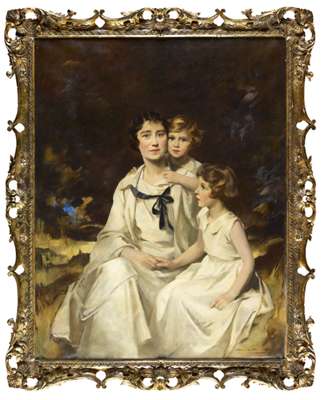
Lot 140

C. EDMOND BROCK (BRITISH FL. 1905-1950)
A FAMILY PORTRAIT OF ELIZABETH, THE QUEEN MOTHER AND HER DAUGHTERS PRINCESS ELIZABE


Auction: 29 May 2008 at 12:00 BST
Description
th and Princess Margaret, Signed and dated 1936, oil on canvas
Dimensions
132cm x 104cm (52in x 41in)
Footnote
Exhibited: The Royal Opera House, Covent Garden, 4th August, 1980, the formal part of a Tribute to Her Majesty Queen Elizabeth The Queen Mother on the occasion of her 80th birthday.
Harrods, London, on the occasion of Her Majesty Queen Elizabeth the Queen Mother's 100th birthday.
New Burlington Galleries, London
Note: This beautifully observed group portrait of Elizabeth, the Queen Mother and her daughters, Princess Margaret Rose and Princess Elizabeth, now Queen Elizabeth II, is a fine example of the work of Edmond Brock. The son of sculptor Sir Thomas Brock, who built the Victoria Memorial in front of Buckingham Palace, Edmond rose to prominence through his talent for portraiture. His reputation travelled across the Atlantic and he crossed over to America several times to paint sitters such as the Countess of Granard, Ogden Mills and Marshall Field.
In England, his sitters included the Earl of Dalkeith, Viscountess Castlereagh and the children of numerous members of high society. He painted several portraits of Princess Elizabeth before her eighth birthday and went on to paint several others of her sister Princess Margaret. In a letter to the artist from 1952, Elizabeth II acknowledges that her father, King George VI, held the portraits of her and her sister in very high esteem and always had one in his sitting room at Buckingham Palace.
Uniquely, a letter from Her Majesty, the Queen Mother commissioning this work survives and will be sold with this painting. Following the portraits he painted of Princess Elizabeth, Brock was in correspondence with the Queen regarding a portrait of her younger daughter, Princess Margaret, three years old at the time, when the Queen requested that a group portrait be painted of her with her two daughters. They sat for the portrait in the artist's studio in Piccadilly and Brock is said to have painted several versions of the oil before being satisfied with the result. He destroyed five or six versions which he considered unsuccessful.
From correspondence we know that the princesses, even at such a young age, remembered the visits to the studio, and having to pass messages to the artist in sign language as he was rather hard of hearing. Brock must have had a particularly kind and engaging manner as it must have been difficult to persuade children to sit still long enough for him to paint them.
In his composition Brock refers to the enduring English tradition of group portraiture, whilst also nodding to Renaissance art, and even Leonardo's seminal The Virgin, and child with St Anne now in the Louvre. The composition is a solid pyramid with the head of the Queen Mother at its apex and her dress and Princess Elizabeth forming the base. Precedents of this subject include Sir Joshua Reynolds' Charlotte Grenville and her children in the National Museum of Wales and .Elisabeth Vigée-Lebrun's Queen Marie-Antoinette and Her Children, currently at the Chateau de Versailles. In the relaxed poses of the princesses seated by their mother and the natural outdoor setting of the sitters, this portrait is much more informal than these earlier examples. Princess Margaret has wrapped her arms around her mother playfully, whilst Princess Elizabeth is seen in profile, holding her mother's right hand and gazing out of the frame. The older daughter's more pensive mood and her relationship with her mother indirectly implies the responsibility and power which are to be invested in her in later life. The right hand of the Queen Mother almost seems to hand down power to the right hand of the seated princess.

